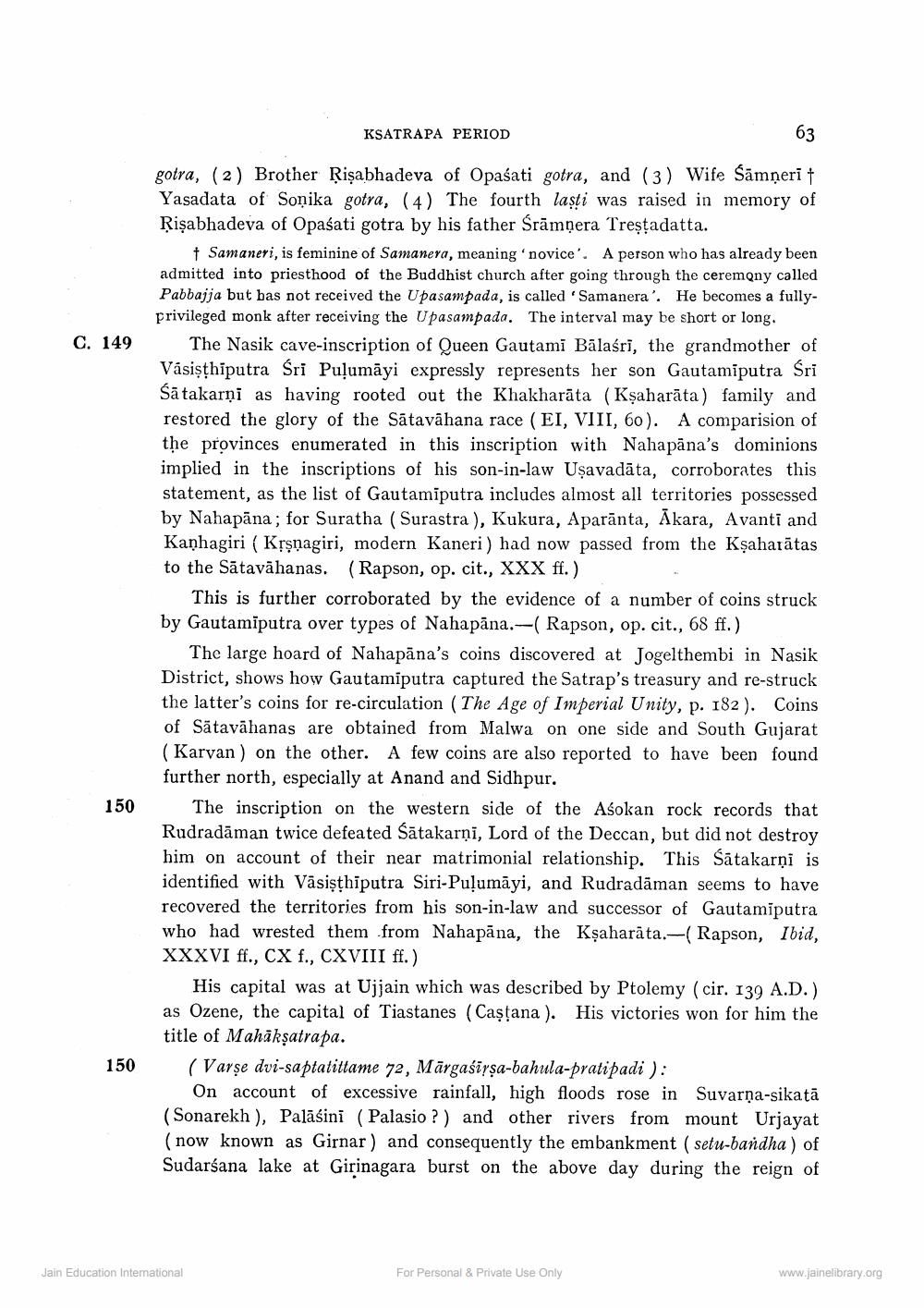________________
KSATRAPA PERIOD
63
C. 149
gotra, (2) Brother Rişabhadeva of Opasati gotra, and (3) Wife Sāmạeri † Yasadata of Sonika gotra, (4) The fourth lasti was raised in memory of Rişabhadeva of Opaśati gotra by his father Śrāmạera Treștadatta.
† Samaneri, is feminine of Samanera, meaning 'novice'. A person who has already been admitted into priesthood of the Buddhist church after going through the ceremony called Pabbajja but bas not received the Upasampada, is called 'Samanera'. He becomes a fullyprivileged monk after receiving the Upasampada. The interval may be short or long,
The Nasik cave-inscription of Queen Gautami Bālasri, the grandmother of Vásişthiputra Śri Puļumāyi expressly represents her son Gautamiputra Śri Śā takarņi as having rooted out the Khakharāta (Kșaharāta) family and restored the glory of the Sātavāhana race (EI, VIII, 60). A comparision of the provinces enumerated in this inscription with Nahapāna's dominions implied in the inscriptions of his son-in-law Uşavadāta, corroborates this statement, as the list of Gautamiputra includes almost all territories possessed by Nahapāna; for Suratha ( Surastra ), Kukura, Aparānta, Ākara, Avanti and Kanhagiri ( Krşşagiri, modern Kaneri) had now passed from the Kşaharātas to the Sātavāhanas. (Rapson, op. cit., XXX ff.)
This is further corroborated by the evidence of a number of coins struck by Gautamiputra over types of Nahapāna.-( Rapson, op. cit., 68 ff.)
The large hoard of Nahapāna's coins discovered at Jogelthembi in Nasik District, shows how Gautamiputra captured the Satrap's treasury and re-struck the latter's coins for re-circulation (The Age of Imperial Unity, p. 182). Coins of Sātavāhanas are obtained from Malwa on one side and South Gujarat ( Karvan) on the other. A few coins are also reported to have been found further north, especially at Anand and Sidhpur.
The inscription on the western side of the Asokan rock records that Rudradāman twice defeated Śātakarņi, Lord of the Deccan, but did not destroy him on account of their near matrimonial relationship. This Satakarņi is identified with Vāsişthiputra Siri-Puļumāyi, and Rudradāman seems to have recovered the territories from his son-in-law and successor of Gautamiputra who had wrested them from Nahapāna, the Kşaharāta.(Rapson, Ibid, XXXVI ff., CX f., CXVIII ff.)
His capital was at Ujjain which was described by Ptolemy (cir. 139 A.D.) as Ozene, the capital of Tiastanes (Castana ). His victories won for him the title of Mahakșatrapa.
(Varșe dvi-saptatittame 72, Mārgaśīrşa-bahula-pratipadi ):
On account of excessive rainfall, high floods rose in Suvarna-sikatā (Sonarekh ), Palāśini (Palasio ?) and other rivers from mount Urjayat (now known as Girnar) and consequently the embankment ( setu-bandha) of Sudarśana lake at Girinagara burst on the above day during the reign of
150
150
Jain Education Interational
For Personal & Private Use Only
www.jainelibrary.org




